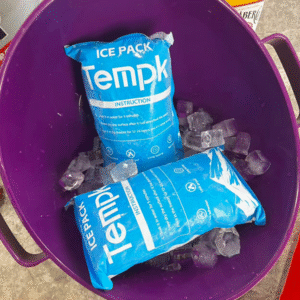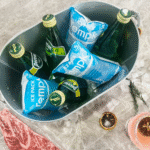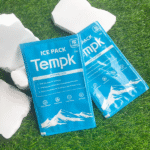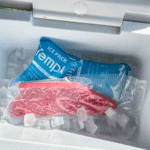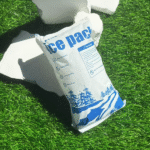Cara Menggunakan Paket Es Kering Kotak Makan Siang dengan Aman
A paket es kering kotak makan siang dapat menjaga makanan tetap dingin selama 4–10 jam bila berukuran dan dikemas dengan benar. Dalam panduan ini, Anda akan belajar cara memilih paket yang tepat, persiapkan itu, dan muat kotak bekal Anda selangkah demi selangkah agar makanan tetap segar dan aman tanpa bocor, kekacauan, atau risiko radang dingin.
-
Bagaimana Anda mengukur paket es kering kotak makan siang untuk pendinginan sepanjang hari?
-
Apa cara paling aman untuk menyiapkan dan mengisi kotak makan siang dengan kantong es kering?
-
Bahan dan tas makan siang mana yang paling cocok dengan kantong es kering?
-
Bagaimana kemasan es kering kotak makan siang dibandingkan dengan kemasan gel atau es balok?
-
Apa itu 2025 tren bahan kantong es kering dan keberlanjutan?
Apa itu Paket Es Kering Kotak Makan Siang, dan kapan Anda harus menggunakannya?
Jawaban singkat: Paket es kering kotak makan siang disegel, sumber dingin yang dapat digunakan kembali dan dirancang untuk menahan suhu di bawah nol derajat dan menjaga makanan tetap aman selama berjam-jam. Ini ideal ketika Anda membutuhkan pendingin yang andal dalam kotak makan siang yang ringkas—saat bepergian, kerja lapangan, sekolah, atau perjalanan sehari—tanpa lelehan es biasa.
Penjelasan yang lebih panjang:
Berbeda dengan es kering yang lepas (CO₂ padat pada suhu sekitar −78 °C), bungkus es kering kotak makan siang adalah a berisi PCM (bahan perubahan fasa) atau paket turunan CO₂ dirancang untuk transportasi makanan sehari-hari. Ini menghindari kekacauan basah, mengurangi risiko bau, dan cocok dengan pengaturan rutin seperti kantor atau sekolah. Bagi sebagian besar pengguna, satu bungkus sedang atau dua bungkus kecil dapat menstabilkan profil suhu kotak makan siang berinsulasi pada umumnya 4–8 jam, dan hingga 10 jam dengan isolasi yang lebih baik dan pra-pendinginan. Jika Anda membawa makanan berisiko tinggi (daging, ikan, susu), kamu ingin sebuah rantai dingin terus menerus dari lemari es hingga waktu makan; paket es kering kotak makan siang membantu Anda mencapai hal itu.
Apakah “es kering” sama dengan kemasan ini?
Tidak tepat. Banyak konsumen mengatakan “bungkus es kering” berarti “bungkus ekstra dingin”. Es kering sebenarnya diatur dalam beberapa konteks dan dapat menyebabkan penumpukan CO₂ di ruang tertutup. Paket es kering kotak makan siang meniru kinerja di bawah nol tanpa menangani es kering yang lepas, jadi lebih aman dan sederhana untuk penggunaan sehari-hari. Jika Anda pernah menggunakan es kering sebenarnya, ventilasi, hindari segel kedap udara, dan tangani dengan sarung tangan.
Bagaimana memilih ukuran paket es kering kotak makan siang yang tepat?
Jawaban singkat: Cocokkan massa paket dengan massa makanan dan lama perjalanan. Dasar praktisnya adalah 20–30% dari berat makanan dalam kemasan dingin untuk hari kerja dan 30–40% untuk hari yang lebih panas atau rute yang lebih panjang.
Penjelasan yang lebih panjang:
Kotak makan siang Anda adalah sistem termal kecil: makanan dan minuman bertindak sebagai beban termal; kotak makan siang plus paket memberikan isolasi dan kapasitas dingin. Untuk ukuran paket es kering kotak makan siang, mulailah dengan aturan praktis ini:
-
Berat makanan (G) × 0,2–0,3 = bungkus gram untuk cuaca sedang dan 6–8 jam.
-
Berat makanan (G) × 0,3–0,4 = bungkus gram untuk cuaca panas atau 8–10 jam.
-
Jika tas Anda terisolasi tipis, menambahkan +10% massa paket.
-
Jika Anda pra-dinginkan makanan dan tas, Anda bisa mengurangi −10% massa paket.
Referensi cepat ukuran (kotak makan siang terisolasi yang khas)
| Ukuran makan siang | Beban makanan (kira-kira.) | Ukuran paket (Baseline) | Apa artinya bagimu |
|---|---|---|---|
| Bento kecil | 400–600 gram | 100–180 gram | Satu kemasan ramping membuat buah/susu tetap stabil untuk bepergian. |
| Makan siang standar | 700–900 gram | 160–270 gram | Satu atau dua kemasan tipis selama 6–8 jam pada suhu kamar. |
| Makan siang yang lezat | 1.0–1,2kg | 250–420 gram | Satu bungkus besar atau dua bungkus sedang selama 8-10 jam; pra-dinginkan membantu. |
Bagaimana cara mengemas paket es kering kotak makan siang untuk waktu yang maksimal?
Jawaban singkat: Pra-dingin, lapisan dengan cerdas, dan meminimalkan ruang kepala.
Tangga: Dinginkan makanan dan bungkus semalaman, letakkan bungkus es kering kotak makan siang di atas dan/atau di sampingnya mudah rusak, dan lindungi celah udara dengan serbet atau kain pembungkus.
Langkah-langkah terperinci:
-
Pra-dingin (praktik terbaik).
-
Letakkan paket es kering kotak makan siang di dalam freezer 8–12 jam.
-
Dinginkan terlebih dahulu kotak makan siang (biarkan terbuka di ruangan sejuk atau letakkan kantong kosong di lemari es selama 30–60 menit).
-
Mulailah dengan makanan yang sudah didinginkan sebelumnya langsung dari kulkas.
-
-
Gunakan penutup dingin dari atas ke bawah.
Udara dingin tenggelam. Tempatkan setidaknya satu paket es kering kotak makan siang di atas. Jika ruang memungkinkan, tambahkan paket datar di bagian bawah untuk membuat gradien suhu. -
Ciptakan “kantong dingin”.
Susun bungkusannya sedemikian rupa menyentuh atau hampir menyentuh makanan berprotein atau susu. Jaga agar buah dan sayuran tetap empuk tetapi dekat dengan massa dingin. -
Isi ruang mati.
Setiap celah udara memanas dengan cepat. Gunakan serbet, handuk kecil, atau pembungkus yang dapat digunakan kembali untuk mengisi ruang di sekitar wadah. Lebih sedikit udara = waktu dingin lebih lama. -
Segel dengan cerdas.
Tutup tas dengan kuat tetapi jangan disegel dengan vakum. Kotak makan siang pada umumnya memiliki porositas kain yang cukup untuk ventilasi normal. Jika menggunakan hardcase, hindari gasket yang terlalu ketat saat menggunakan es kering yang sebenarnya. -
Jauhkan dari matahari langsung.
Bayangkan kotak makan siangnya. Panas yang terpancar memperpendek waktu dingin yang efektif 20–30%.
Tata letak yang cocok untuk kebanyakan orang (kotak standar)
-
Dasar: sandwich atau hidangan utama dalam wadah yang kaku.
-
Tengah: sisi buah/sayuran, yogurt atau keju.
-
Atas: paket es kering kotak makan siang berbaring telentang seperti tutup yang dingin.
-
Kekosongan samping: serbet atau pembungkus untuk mengurangi volume udara.
Apakah paket es kering kotak makan siang aman untuk anak-anak dan tempat kerja?
Jawaban singkat: Ya—bila Anda mengikuti tindakan pencegahan dasar.
Bungkus kantong es kering kotak makan siang dengan selongsong jika terasa “terlalu dingin untuk disentuh,” jauhkan dari kulit telanjang untuk waktu yang lama, dan menggunakan makanan yang aman, kemasan tahan tusukan.
Praktik terbaik untuk penggunaan yang aman:
-
Penanganan: Jika kemasan sangat dingin, keluarkan dari freezer, gunakan bungkus kain tipis.
-
Waktu kontak: Hindari meletakkan bungkusan langsung pada kulit telanjang.
-
Wadah: Memilih Bebas BPA permukaan kontak dan film yang aman untuk makanan.
-
Ventilasi: Untuk es kering sejati (co₂ solid), jangan pernah memasukkannya ke dalam wadah kedap udara; biarkan gas keluar. Sebagian besar “paket es kering” rumah tangga adalah cairan pendingin yang tersegel, jadi kotak makan siang biasa tidak masalah.
-
Pelabelan: Tandai bungkusnya “Jangan dimakan.” Untuk anak-anak, memilih tepi lembut bungkus yang tidak akan melukai buah atau jari.
Bagaimana perbandingan paket es kering kotak makan siang dengan paket gel atau es balok?
Jawaban singkat: Paket es kering kotak makan siang menghasilkan suhu dingin yang lebih lama pada suhu yang lebih rendah di ruangan yang padat, sedangkan gel cocok untuk pendinginan sedang dan es biasa paling murah tetapi berantakan.
Sekilas tentang perbandingan
| Pilihan | Pita suhu yang khas | Waktu dingin (massa yang sama) | Risiko kekacauan | Penggunaan ideal |
|---|---|---|---|---|
| Paket es kering kotak makan siang | pita di bawah nol hingga −5 °C | ★★★★☆ | Sangat rendah | Makanan berisiko tinggi, hari-hari yang panas, perjalanan panjang |
| Paket gel | ~0–5 °C pita | ★★★☆☆ | Rendah | Makan siang umum, cuaca sedang |
| Es batu/balok | 0 pita °C | ★★☆☆☆ | Tinggi (meleleh) | Perjalanan yang sangat singkat, hanya anggaran |
Membawa pergi: Jika keamanan pangan atau hari yang panjang adalah prioritas Anda, itu paket es kering kotak makan siang menang. Untuk salad ringan atau makanan ringan di musim semi/musim gugur, paket gel mungkin cukup.
Peduli, penggunaan kembali, dan pembuangan: jadikan paket es kering kotak makan siang Anda tahan lama
Jawaban singkat: Perlakukan paket Anda seperti peralatan masak premium. Pembersihan lembut, siklus pembekuan penuh, dan penyimpanan yang hati-hati memaksimalkan masa pakai.
Daftar periksa perawatan rutin:
-
Bersihkan setelah digunakan. Lap tangan dengan sabun lembut; hindari pelarut yang keras.
-
Keringkan sebelum dibekukan. Kelembapan dapat membeku di bagian luar dan menempel pada bungkus makanan.
-
Flat beku. Kemasan datar dapat ditumpuk lebih baik dan mendistribusikan dingin secara merata sebagai “penutup dingin”.
-
Periksa setiap tiga bulan. Perhatikan apakah jahitannya aus atau bengkak. Pensiunkan paket yang tertusuk.
-
Simpan pada muatan freezer 25–60%.. Freezer yang dikemas terlalu banyak akan membeku lebih lambat; freezer yang dikemas dalam kemasan lebih banyak berputar dan membuang energi.
Akhir kehidupan: Jika paket es kering kotak makan siang casingnya rusak, ikuti panduan pembuangan dari pabriknya. Banyak paket baru yang digunakan tidak beracun, aman untuk TPA isi; beberapa program menerima casing untuk daur ulang bahan.
Pemilih Paket Es Kering Kotak Makan Siang 5 menit (interaktif)
Gunakan pemeriksaan mandiri ini untuk memilih pengaturan yang tepat. Lingkari jawaban Anda, lalu baca hasilnya.
-
Durasi perjalanan hari ini? A) ≤4 jamB) 5–8 jam C) 9–10 jam
-
Suhu sekitar? A) Di dalam ruangan 20–23 °C B) Hangat 24–29 °C C) Panas 30–35 °C
-
Jenis makanan? A) Makanan ringan/saladB) Susu/dagingC) Sushi/makanan laut
-
Isolasi kotak makan siang? A) tebal B) Sedang C) Tas jinjing tipis/fashion
-
Freezer pra-dinginkan? A) Penuh 12 jam B) 6 jam C) Tidak ada waktu
Jika Anda memilih kebanyakan A: Satu kecil paket es kering kotak makan siang (100–150 gram) di atas.
Kebanyakan B: Satu paket sedang (160–270 gram) di atas; paket bawah ramping opsional.
Kebanyakan C: Satu bungkus besar (250–400 gram) atas + satu bagian bawah sedang, mengisi kesenjangan, naungan yang ketat.
Kiat lanjutan untuk pengguna tingkat lanjut
Ekor panjang: tas makan siang terisolasi dengan paket es kering
-
Wadah makanan pra-tahap di lemari es tepat di samping paket cadangan 30 menit.
-
Meletakkan protein dan susu paling dekat dengan paket es kering kotak makan siang.
-
Tambahkan a lapisan reflektif atau eksterior berwarna terang untuk mengurangi pancaran panas.
Ekor panjang: lembaran es kering pendingin makan siang yang dapat digunakan kembali
-
Es kering paket lembaran lipat di sekitar wadah untuk meningkatkan kontak permukaan.
-
Untuk kotak bento berbentuk aneh, lembaran dapat mengungguli satu bungkus batu bata dengan massa yang sama.
Ekor panjang: paket es kering kotak makan siang kecil untuk anak-anak
-
Mencari lembut, sudut membulat Dan aman untuk dikunyah casing.
-
Tambahkan sedikit kartu kertas dengan aturan penanganan dan kontak darurat.
Kasus dunia nyata
Studi kasus: Seorang teknisi pulang pergi 90 menit sekali jalan pada bulan Juli dengan a 900 g makan siang (yogurt, bungkus ayam, beri). Beralih dari satu paket gel ke a paket es kering kotak makan siang (220 G) dan pra-pendinginan tas memperpanjang suhu aman ~5 jam hingga ~9 jam. Bungkusan itu diletakkan rata di atasnya, dengan serbet mengisi celah samping untuk mengurangi volume udara.
2025 tren: apa yang baru dalam bahan bungkus es kering kotak makan siang?
Ringkasan: Di dalam 2025, film bebas PFAS, casing PET daur ulang, Dan Media pendingin yang direklamasi CO₂ menjadi arus utama. Produsen sedang mengoptimalkan kurva perubahan fasa jadi a paket es kering kotak makan siang menahan suhu dingin lebih lama tanpa menambah jumlah besar. Harapkan lebih banyak format lembar modular, lengan yang aman untuk mesin pencuci piring, Dan Instruksi perawatan berkode QR.
Sorotan cepat
-
Keberlanjutan: Lebih banyak paket yang digunakan CO₂ yang direklamasi sumber dan cangkang yang dapat didaur ulang.
-
Penyetelan kinerja: Lebih sempit pita transisi PCM simpan makanan di bawah 5 °C lebih lama.
-
Kegunaan: Tipis, lembaran fleksibel yang membungkus wadah bento dan menumpuknya rata di dalam freezer.
Wawasan pasar: Nilai konsumen keandalan bebas kebocoran Dan ketebalan kompak atas massa mentah. Merek yang mempublikasikan tabel ukuran sederhana Dan panduan perawatan dapatkan penggunaan berulang dan ulasan yang lebih baik.
Pertanyaan yang sering diajukan
Q1: Bisakah saya terbang dengan paket es kering kotak makan siang?
Ya—paket pendingin yang tersegel diterima secara luas. Jika menggunakan es kering yang sebenarnya, menghormati kuantitas maskapai dan aturan ventilasi. Periksa kebijakan operator Anda.
Q2: Berapa lama bungkus es kering kotak makan siang tetap dingin?
Khas 4–8 jam untuk makan siang standar dan hingga 10 jam dengan pra-dinginkan, isolasi yang bagus, dan paparan sinar matahari minimal.
Q3: Apakah kondensasi normal?
Sedikit kelembapan di luar kotak adalah hal yang normal. Gunakan a lengan lembut atau bungkus untuk melindungi kertas/barang elektronik di dalam tas yang sama.
Q4: Bisakah bungkusnya menyentuh wadah makanan saya secara langsung?
Ya—kontak meningkatkan pendinginan. Hindari kontak langsung dengan kulit telanjang dalam waktu lama.
Q5: Apakah saya perlu dua bungkus?
Menggunakan dua ketika hari masih panjang, cuacanya panas, atau kotak makan siang Anda terisolasi tipis. Tempatkan satu di atas, satu di bagian bawah.
Ringkasan dan Rekomendasi
Poin -poin penting: A paket es kering kotak makan siang memberi lebih lama, perlindungan lebih dingin dibandingkan gel atau es dengan sedikit kekacauan. Ukuran paket di 20–30% massa makanan hampir setiap hari, 30–40% dalam panas. Dinginkan terlebih dahulu semalaman, tempatkan paketnya di atas seperti tutup yang dingin, Dan mengisi celah udara. Untuk anak-anak dan kantor, memilih tepi lembut, aman untuk makanan casing dan aturan penanganan dasar.
Langkah selanjutnya:
-
Perkirakan milik Anda massa paket dengan rumus cepat.
-
Pra-dingin mengemas, makan siang, dan tas.
-
Mengemas dari atas ke bawah, mengisi celah udara, hindari sinar matahari.
-
Untuk hari-hari yang panas, tambahkan paket bawah.
-
Lacak hasilnya selama seminggu dan sesuaikan rutinitas Anda.
CTA: Ingin rekomendasi cepat? Bagikan milik Anda beban makanan, suhu lingkungan, Dan jam—Aku akan mengambil ukuran a paket es kering kotak makan siang pengaturan untuk Anda.






